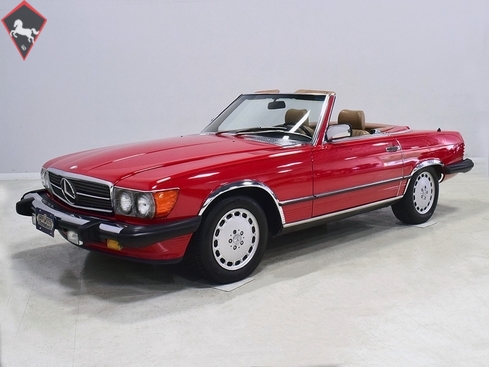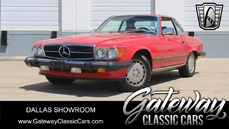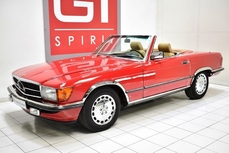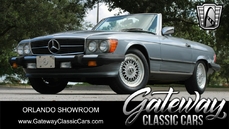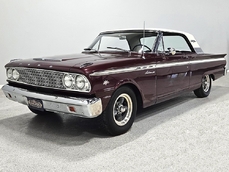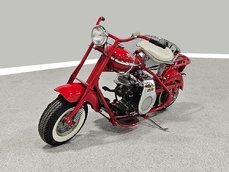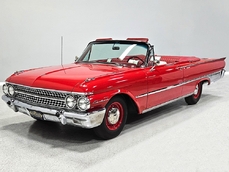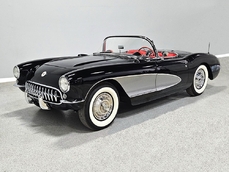Mercedes-Benz 560SL w107 5.6 liter SOHC V8 1989
General description :
Mercedes-Benz built the R107 SL for nearly two decades and in that time, managed to keep it fresh and desirable, so much so that it remained THE luxury/performance roadster throughout the ‘80s. There were faster cars, more expensive cars, more exclusive cars, but none that could capture the SL’s blend of all three. In short, if you had money and wanted everyone to know it, there was no better tool for advertising it than the R107. In its final iteration, the 560SL actually became a formidable machine, along with a host of comfort and convenience upgrades that make it the one to own if you’re looking for Mercedes’ ultimate status symbol. And in truth, they’re also great cars to drive, so don’t be dissuaded by their image, because they are just about the best blend of performance, comfort, and bulletproof engineering ever created by the engineers in Stuttgart.
This handsome 1989 Mercedes-Benz 560SL is a fantastic combination of affordable price, great specifications, and attractive colors. The Signal Red over tan combination is elegant and sporting at once, the perfect choice for the top-of-the-line SL. It’s certainly flashy and on the trim SL, it looks like the sheetmetal was shrink-wrapped over the mechanicals and the chiseled character lines along the bodywork really stand out. This car has never been hit or rusty, and that’s original 1989 paint, which means there are no nasty surprises waiting for you underneath. Build quality is exemplary, which you’d expect from a car whose engineers referred to as “der Panzerwagon,” AKA the tank. It feels incredibly robust, and this is a 30-year-old machine! The US-spec rubber bumpers have become so familiar that they’re not really a demerit today and they remain in excellent condition with no UV damage or cracks. There’s still quite a bit of chrome and it’s all excellent, from the grille to the wonderfully heavy-feeling bright trim on the trunk lid, and it wears accessory chrome wheel arches and defroster vents. Like most SLs, this car has led an easy life as a summertime toy.
The tan leather interior is more evidence that someone has loved this car all its life. With the 560, leather upholstery was now standard, wrapped around supportive seats that hold you in place without feeling tight or restrictive. There’s some very, very minor wear on the outer bolster of the driver’s seat, which is to be expected, but the rest looks pretty good. Carpets, door panels, and the real burled walnut on the console all remain quite presentable. The big steering wheel was leather-wrapped in the 560, and the big, round gauges are a model of functionality, able to be read at a glance. The original AM/FM/cassette stereo still sounds pretty good and looks right in the dash, unlike modern head units. The windows power up and down properly, and even the temperature gauge in the center of the dash keeps an accurate eye on exterior temperatures (this is not an owner add-on). The trunk is beautifully upholstered using the same plush carpets as the interior, and you’ll find the original unused Pirelli spare tire and jack tucked underneath, as well as the original tool roll. All SLs came standard with both a folding cloth top and a removable hardtop, and both are included. The convertible top has some minor damage that has been repaired between the rear windows, but it is otherwise very presentable—besides, if you’re doing it right, you’ll only use it in emergencies.
But the biggest improvements came under the skin, starting with the big 5.6 liter OHC V8 engine, which powered all Mercedes-Benz flagship vehicles in the 1980s. In the relatively lightweight SL, performance is impressive, particularly on the roll. There’s torque available at any speed and I would liken this SL more to a German Mustang than a lightweight sports car. It’s impeccably smooth at all times, even when you’re running hard, and it has proven itself over the decades as one of the toughest machines ever to come out of the Mercedes-Benz factory. Mileage on these cars seems to be a non-issue, as they’ll seemingly run for hundreds of thousands of miles without any diminution in performance or reliability, so it’s a mistake to regard a car with mileage like this one as second-best. Maintenance is what really matters, and this car has been properly maintained all its life, a fact that is more than demonstrated by its outstanding road manners.
All 560SLs received a 4-speed automatic transmission with a deep overdrive gear, so it’s an effortless high-speed cruiser, especially with 2.47 gears out back (remember this car was born to run the Autobahn). For smoothness, it is programmed to start in 2nd gear, which makes it feel a little sleepy, but a quick prod of the throttle will drop it into 1st and the car takes off like a rocket—German Mustang indeed! Otherwise, shifts are smooth and unobtrusive, and only Mercedes-Benz seems to have mastered the ride/handling compromise that makes the SL so much fun. Drive gently, and it feels luxury car smooth, with bumps feeling far away and never upsetting the rock-solid platform. Drive it aggressively and it is happy to run with you, with good reflexes and a surprisingly amount of grip. Powerful 4-wheel disc brakes are augmented by ABS, another 560 upgrade, and there’s a wonderful V8 burble from the tailpipes out back. This car sits on a set of factory alloys as well as some fat 215/65/15 Goodyear radials that fill the fenders just right.
Documentation includes the original manuals.
We’ve sold quite a few of these and their enduring appeal surely comes down to their awesome build quality and fun-to-drive road manners. This is a lot of car for the money, and if you’ve been watching R107 prices lately, you know that these are on the move in a big way. We can’t promise this one will make you rich overnight, but we can promise that you’ll be having too much fun to worry about it. Call today!
Harwood Motors always recommends and welcomes personal or professional inspections of any vehicle in our inventory prior to purchase.
http://www.harwoodmotors.com/vehicles/inventory_details.php?id=1216
1989 Mercedes-Benz 560SL w107 5.6 liter SOHC V8 is listed sold on ClassicDigest in Macedonia by for $19900.
Car Facts
Car type : Car Make : Mercedes-Benz Model : 560SL w107 Model Version : 5.6 liter SOHC V8 Engine size : 5.6 Model Year : 1989 Location : Ohio
Sold
Seller Information
Sold
People who viewed this Mercedes-Benz 560SL w107 also viewed similar Mercedes-Benz listed at ClassicDigest
Other cars listed for sale by this dealer
About Mercedes-Benz
In the annals of automotive history, the journey of Mercedes-Benz is a tale that unfolds with the ingenuity of its founding pioneers. In the year 1886, Karl Benz crafted the Benz Patent Motorwagen, a creation that would go down in history as the world's inaugural automobile. Unbeknownst to him, this moment marked the genesis of what would evolve into the most illustrious premium car manufacturer globally. The financial underpinning of this pioneering venture, interestingly, was provided by Karl Benz's wife, Bertha Benz, demonstrating a remarkable partnership that would set the tone for Mercedes-Benz's legacy.A parallel narrative emerged not far away, as Daimler-Motoren-Gesellschaft, founded by Gottlieb Daimler and Wilhelm Maybach, entered the scene. In 1901, they unveiled their automobile under the now-famous moniker "Mercedes," meaning "godsend" in Spanish. This name was bestowed upon the car at the behest of Emil Jellinek's daughter, the distributor for Daimler-Motoren-Gesellschaft. The wheels of innovation were set in motion.
Fast forward to 1926, a pivotal year that witnessed the merger of Daimler with Benz & Cie., culminating in the birth of Daimler-Benz. The amalgamation saw the adoption of "Mercedes-Benz" as the distinguished trademark for their automobiles, fusing the legacies of two visionary entities into one.
Contrary to perceptions of conservatism, the trajectory of Daimler-Benz unfolds as a chronicle of industry firsts. From the introduction of the honeycomb radiator to the float carburetor, and the pioneering implementation of four-wheel brakes in 1924, Daimler-Benz consistently pushed the boundaries of automotive innovation. The diesel-powered Mercedes-Benz 260 D in 1936 marked the inception of diesel engines in passenger cars. The iconic Mercedes-Benz 300SL Gullwing made history as the first car with direct fuel injection, albeit the Gutbrod's tiny 2-stroke engine can claim precedence.
Safety innovations became a hallmark, with Béla Barényi's patented safety cell design in the "Ponton"-models in 1951, featuring front and rear crumple zones. The W116 450SEL 6.9 saw the introduction of the Anti-Lock Brake system (ABS), another pioneering safety feature. From the first production airbags and beyond, the legacy of "firsts" continued to be etched into the fabric of Daimler-Benz.
Over its centennial journey, Mercedes-Benz has not merely produced cars but has sculpted automotive icons. The SSKL, 710 SSK Trossi Roadster, 770K Grosser, 540K Spezial Roadster, 300SL Gullwing, w100 600 Pullman, w111 280SE 3.5 Flachkühler, w113 230SL Pagoda, w109 300 SEL 6.3, and w201 2.3-16 Cosworth stand testament to the brand's commitment to engineering excellence.
The roaring Silver Arrows, or "Silberpfeile," including the W 25, W 125, W154, W165, and W196, created a legacy of dominance on the racetrack. These machines were not merely cars; they were expressions of precision, speed, and an indomitable spirit that left their competitors in the dust.
As Mercedes-Benz marches into the future, it does so not just as an automaker but as a custodian of a legacy, a torchbearer of innovation, and a beacon of automotive excellence. The road ahead is sure to witness the continued fusion of cutting-edge technology, timeless design, and an unwavering commitment to setting new standards in the world of automobiles.
One luminary figure who left an indelible mark was Béla Barényi, often heralded as the "father of passive safety" for his pioneering work in safety engineering. His patented safety cell design, featuring front and rear crumple zones, became a hallmark of Mercedes-Benz's commitment to occupant safety, setting new standards that reverberated throughout the automotive world.
Moving through the chronicles, the collaborative genius of Wilhelm Maybach, alongside Gottlieb Daimler, laid the foundation for Daimler-Motoren-Gesellschaft. Their innovations not only birthed the first Mercedes but established a culture of relentless pursuit of technological excellence that remains integral to Mercedes-Benz's DNA.
In the post-merger era of 1926, Ferdinand Porsche emerged as a prominent figure within Mercedes-Benz. His work on the Mercedes-Benz S-Type, a supercharged race car, garnered acclaim and set the stage for a legacy that extended far beyond the marque. Porsche's impact would later extend to his eponymous company, but his influence at Mercedes-Benz during those formative years was pivotal.
As the 20th century progressed, the legendary Rudolf Uhlenhaut emerged as a key figure. Uhlenhaut, an accomplished engineer and the driving force behind the iconic Silver Arrows, played a crucial role in Mercedes-Benz's dominance in motorsports. His engineering prowess and attention to detail were instrumental in creating some of the most formidable racing cars of the era.
In the latter half of the century, figures like Bruno Sacco, the head of design at Mercedes-Benz from 1975 to 1999, left an indelible imprint on the brand's aesthetic identity. Sacco's design philosophy, characterized by clean lines and timeless elegance, shaped iconic models like the W126 S-Class and the W201 190E, solidifying Mercedes-Benz's reputation for luxury and sophistication.
The narrative would be incomplete without acknowledging the contributions of engineers like Hans Scherenberg, whose leadership in the 1970s ushered in a new era of technological innovation at Mercedes-Benz. Scherenberg's tenure saw the development of groundbreaking technologies, including the Anti-Lock Brake system (ABS) and the introduction of airbags in production cars.
